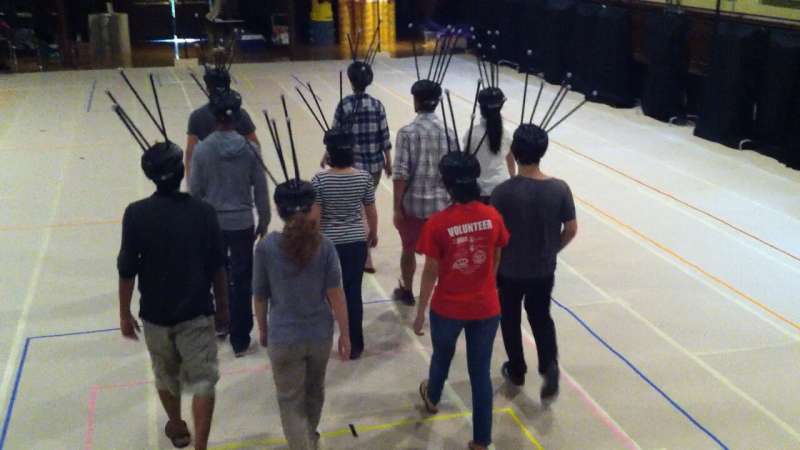Human crowds are best modeled by a ‘visual neighborhood’
Human crowd dynamics are best predicted by a visual neighborhood model, based on the visual fields of each person in the crowd. Birds flock, fish school, and human crowds, too, move in a collective motion pattern. Understanding human crowd behavior can be useful for preventing jams, crushes, and stampedes. Mathematical models of collective motion are typically based on characterizing the local interactions between individuals.
One popular approach, called a metric model, is to quantify forces of attraction, repulsion, and velocity alignment for all neighbors within a fixed radius from the focal individual. Alternatively, in a topological model the focal individual might be influenced by a fixed number of near neighbors, regardless of the distance to the focal individual.
For their study published in PNAS Nexus, Trenton Wirth and colleagues asked participants to walk in real and virtual crowds of varying densities, then changed the walking direction of some neighbors to see how the participants responded. The authors found that the data produced was better predicted by the metric model than by the topological model.
But the best model was based on the visual motions of the neighbors the focal individual could see. In dense crowds, near neighbors may partially or completely block the view of more distant neighbors, removing the distant neighbors from the focal pedestrian’s input. Pursuing a visual model promises more realistic simulations of crowd dynamics, according to the authors.
More information:
Trenton D Wirth et al, Is the neighborhood of interaction in human crowds metric, topological, or visual?, PNAS Nexus (2023). DOI: 10.1093/pnasnexus/pgad118
Citation:
Human crowds are best modeled by a ‘visual neighborhood’ (2023, May 17)
retrieved 17 May 2023
from https://phys.org/news/2023-05-human-crowds-visual-neighborhood.html
This document is subject to copyright. Apart from any fair dealing for the purpose of private study or research, no
part may be reproduced without the written permission. The content is provided for information purposes only.

Human crowd dynamics are best predicted by a visual neighborhood model, based on the visual fields of each person in the crowd. Birds flock, fish school, and human crowds, too, move in a collective motion pattern. Understanding human crowd behavior can be useful for preventing jams, crushes, and stampedes. Mathematical models of collective motion are typically based on characterizing the local interactions between individuals.
One popular approach, called a metric model, is to quantify forces of attraction, repulsion, and velocity alignment for all neighbors within a fixed radius from the focal individual. Alternatively, in a topological model the focal individual might be influenced by a fixed number of near neighbors, regardless of the distance to the focal individual.
For their study published in PNAS Nexus, Trenton Wirth and colleagues asked participants to walk in real and virtual crowds of varying densities, then changed the walking direction of some neighbors to see how the participants responded. The authors found that the data produced was better predicted by the metric model than by the topological model.
But the best model was based on the visual motions of the neighbors the focal individual could see. In dense crowds, near neighbors may partially or completely block the view of more distant neighbors, removing the distant neighbors from the focal pedestrian’s input. Pursuing a visual model promises more realistic simulations of crowd dynamics, according to the authors.
More information:
Trenton D Wirth et al, Is the neighborhood of interaction in human crowds metric, topological, or visual?, PNAS Nexus (2023). DOI: 10.1093/pnasnexus/pgad118
Citation:
Human crowds are best modeled by a ‘visual neighborhood’ (2023, May 17)
retrieved 17 May 2023
from https://phys.org/news/2023-05-human-crowds-visual-neighborhood.html
This document is subject to copyright. Apart from any fair dealing for the purpose of private study or research, no
part may be reproduced without the written permission. The content is provided for information purposes only.
